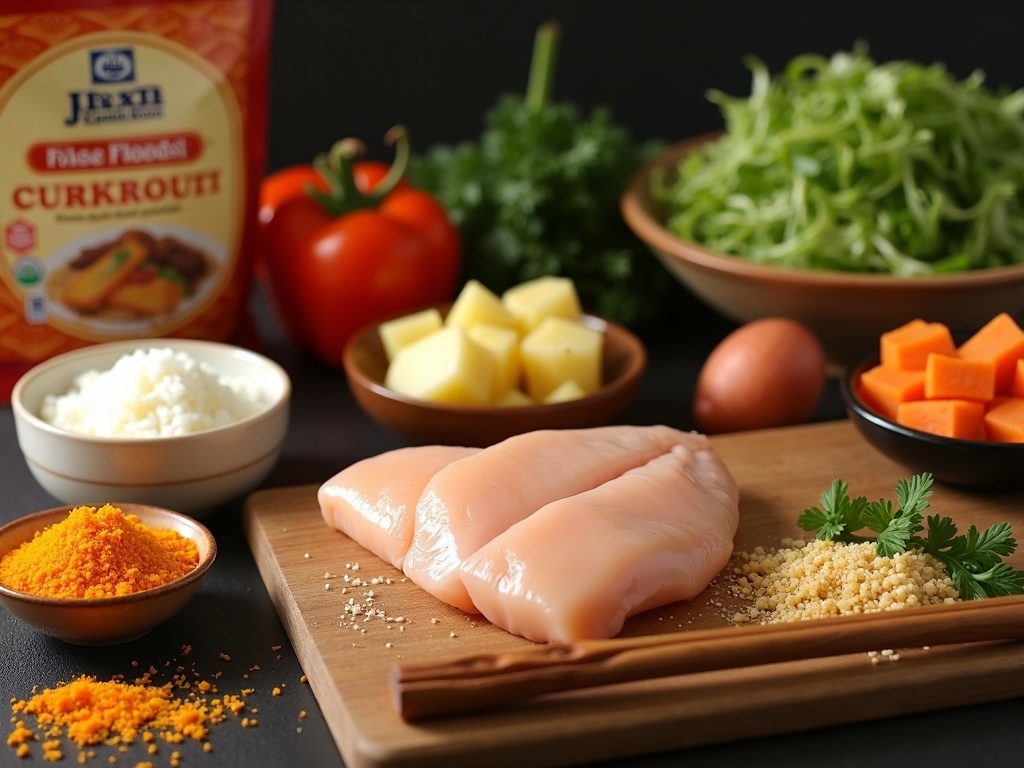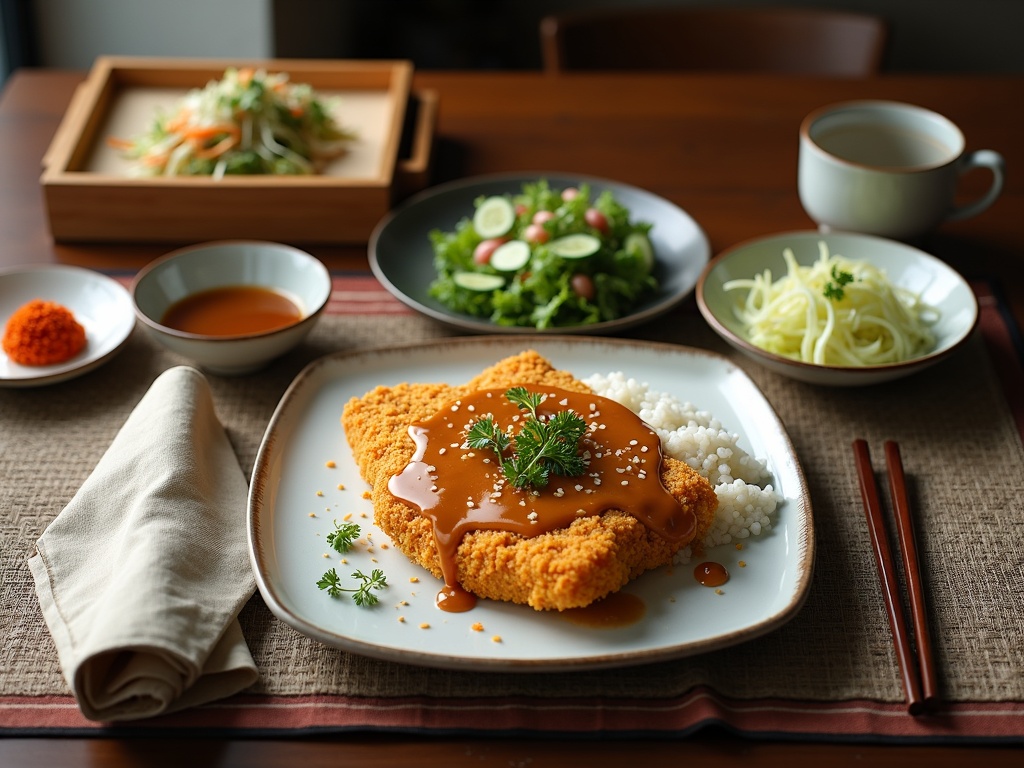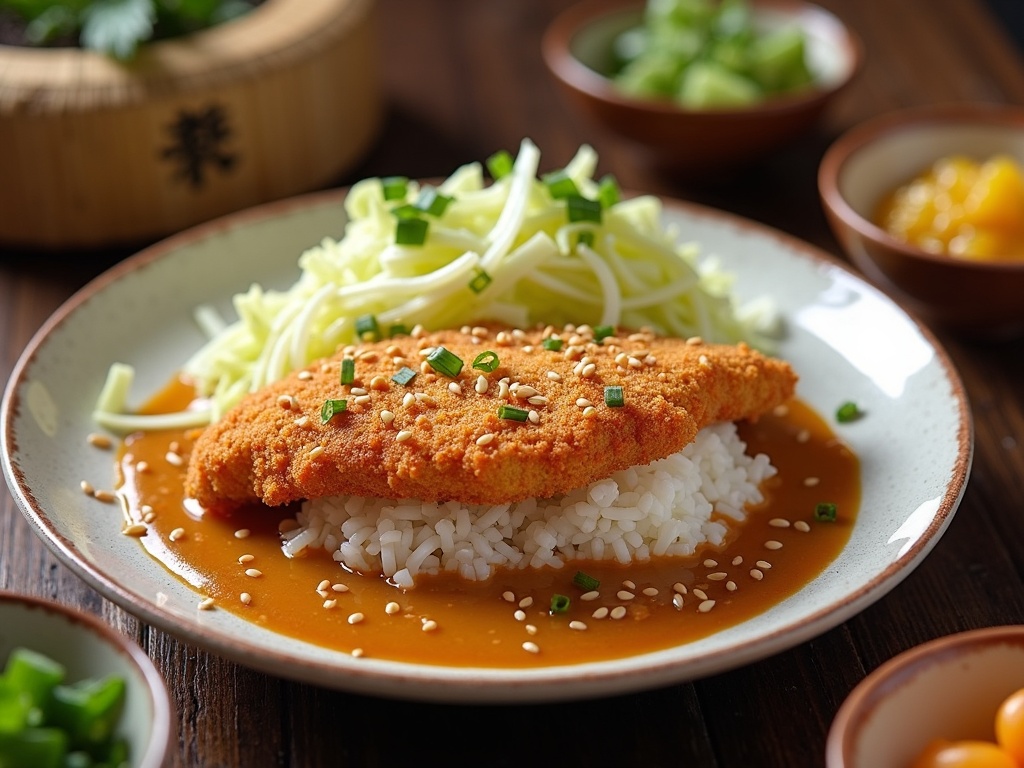Katsu curry recipe, originating in the late 19th century Japan, represents one of the most successful culinary fusions in modern food history by combining Western-inspired breaded cutlets with a rich, aromatic Japanese curry sauce. This beloved comfort food is traditionally served with fluffy white rice and shredded cabbage, creating a perfect balance of textures and flavors that has become a cornerstone of Japanese cuisine.
Find In This Article
Key Takeaways
- The dish features a crispy panko-breaded cutlet (typically chicken or pork) paired with a silky, slightly sweet curry sauce for a satisfying texture contrast.
- The three-step coating process (flour, egg, panko breadcrumbs) and proper oil temperature (170-180°C) are essential for achieving the signature golden crust.
- Quality curry roux blocks form the base of the sauce, combined with sautéed onions, carrots, and potatoes for a rich, flavorful curry.
- Traditional presentation includes shredded cabbage, Japanese pickles, and perfectly cooked rice for a complete dining experience.
- The dish contains approximately 700-900 calories per serving, with about 30g of protein, 75g of carbohydrates, and 25g of fat.
The Story Behind Your Katsu Curry
I first discovered katsu curry during my travels to Tokyo and was immediately captivated by its fascinating history. Originating in Japan during the late 19th century, this dish represents one of the most successful culinary fusions in modern food history.
A Delicious Cultural Blend
Katsu curry emerged as a beautiful marriage between Western and Japanese cuisines in the post-World War II era. The dish combines two distinct elements: the breaded cutlet (katsu) – inspired by Western cooking techniques – and a rich, aromatic curry sauce that had already been adapted to Japanese tastes. The genius lies in its simplicity – crispy panko-breaded meat paired with a silky, slightly sweet curry sauce.
What makes this dish special is how it transformed from an exotic foreign food into a cornerstone of Japanese comfort cooking. You’ll find it served in homes, school cafeterias, and specialty restaurants throughout Japan, each with their own slight variations but always maintaining the core elements that make it so satisfying.
Traditional Presentation and Nutrition
When served traditionally, katsu curry comes with a generous portion of fluffy white rice and thinly shredded cabbage. The cabbage provides a fresh, crisp contrast to the rich curry and fried cutlet. This classic presentation creates a perfect balance of textures and flavors that has stood the test of time.
From a nutritional standpoint, a typical serving contains between 700-900 calories, making it a substantial meal. While I enjoy the traditional chicken or pork versions, I’ve found that vegetable curry variations can be equally satisfying. For meat lovers, adapting the technique to create beef curry recipes offers an interesting twist on the classic.
The popularity of katsu curry has inspired countless variations worldwide. Some home cooks prepare a slow cooker chicken curry with katsu-style chicken on top for a fusion approach. Others experiment with cauliflower curry as a lighter alternative, or create lamb curry with katsu techniques for special occasions.
What I find most compelling about katsu curry is how it represents Japanese cuisine’s adaptability – taking foreign influences and transforming them into something uniquely their own. This dish isn’t just delicious; it’s a tasty history lesson on your plate.
Essential Ingredients for Perfect Katsu
Creating a delicious katsu curry at home starts with gathering the right ingredients. I’ve found that quality components make all the difference between an ordinary dish and an authentic Japanese experience.
Protein and Coating Basics
The foundation of any great katsu curry begins with selecting the right protein. For each portion, you’ll need 150-200g of boneless chicken breast, which creates a tender and juicy cutlet. If you prefer alternatives, lamb curry options can provide a different flavor profile while maintaining the essence of this beloved dish.
Panko breadcrumbs are non-negotiable for authentic katsu – you’ll need about 100g for coating. Unlike regular breadcrumbs, panko creates that signature light, airy crunch that makes katsu so satisfying. The larger, flakier texture allows the cutlet to stay crispy even after the curry sauce is added.
Curry Components and Accompaniments
The heart of katsu curry lies in its flavorful sauce. For each serving, you’ll need 100-150g of curry roux from trusted brands like S&B or House Foods. These pre-made curry blocks combine spices, thickeners, and seasonings that create that distinctive Japanese curry flavor with minimal effort.
The vegetables that form the base of your curry sauce are equally important:
- 100g carrots per serving, cut into bite-sized pieces
- 100g potatoes per serving, diced into uniform cubes
- 50g fresh cabbage per serving, finely shredded as a side
Short or medium-grain white rice (100-150g dry per serving) provides the perfect base for soaking up the rich curry sauce. For a vegetable-forward alternative, cauliflower curry elements can be incorporated into your dish for added nutrition and texture variation.
I’ve discovered that the perfect katsu curry balances the crispy protein with a thick, flavorful sauce and tender vegetables. When craving something with a different protein, beef curry recipes can offer a heartier alternative while maintaining the comfort food appeal.
For a lighter weeknight option, slow cooker chicken curry methods can be adapted for the sauce portion, allowing you to focus on perfecting the katsu coating while the curry simmers. When serving guests with diverse preferences, having vegetable curry components available ensures everyone can enjoy this classic Japanese comfort food.

Mastering the Crispy Cutlet
The star of any katsu curry is undoubtedly the crispy cutlet that sits atop the aromatic sauce. I’ve found that getting this element right makes all the difference between an ordinary meal and an extraordinary one.
Perfect Frying Technique
The key to achieving that signature golden crust starts with the oil temperature. I heat my oil to precisely 170-180°C (340-360°F) – this temperature range is critical because it allows the coating to crisp up quickly without burning while ensuring the meat cooks through perfectly. Too cool, and the cutlet absorbs excess oil; too hot, and you’ll burn the exterior before the inside cooks.
The three-step coating process creates that distinctive katsu texture:
- First, I dust the meat thoroughly in flour, shaking off any excess
- Next, I dip it in beaten eggs, ensuring complete coverage
- Finally, I press it firmly into panko breadcrumbs, making sure every inch is coated
When frying, I carefully lower the coated cutlet into the hot oil and cook for 4-5 minutes on each side until it develops that gorgeous golden-brown color. The result is a protein-packed dish delivering approximately 30g of protein per serving.
For those who prefer a lighter option, I’ve had great results using an air fryer. I spray the breaded cutlet with a light coating of oil and air-fry at 200°C (390°F) for about 12-15 minutes, flipping halfway through. While the texture differs slightly from deep-frying, it’s a fantastic alternative that maintains the crispy exterior.
This preparation method works brilliantly whether you’re making a traditional beef curry with crispy cutlets or venturing into vegetarian territory with cauliflower curry variations. I’ve even used this technique when preparing lamb curry with spectacular results.
The contrast between the crispy cutlet and the smooth, flavorful curry sauce creates that perfect textural balance that makes katsu curry so satisfying. For a complete meal, I often pair it with vegetable curry sides or even incorporate the crispy technique into a slow cooker chicken curry for a fusion dish that combines multiple cooking methods.
The real magic happens in that moment when you slice through the cutlet – the satisfying crunch giving way to tender meat inside. It’s this contrast that makes katsu curry a standout dish and worth mastering the crispy cutlet technique. With practice, you’ll develop an intuitive feel for when the cutlet is perfectly done, recognizing that ideal golden hue that signals crispy perfection awaits.

Creating Your Curry Sauce
The heart of any katsu curry lies in its velvety, aromatic sauce. I’ve found that taking time with this component pays off tremendously in the final dish. The process starts with building layers of flavor through careful cooking techniques.
I begin by heating a tablespoon of oil in a deep pan over medium heat. The onions go in first, and I sauté them patiently until they turn translucent and slightly golden—about 5-7 minutes. This slow cooking releases their natural sweetness, forming a flavorful foundation for the sauce.
Next, I add diced carrots and potatoes to the softened onions. These vegetables need to be cut into similar-sized pieces (about 1cm cubes) to ensure even cooking. I stir them frequently to prevent sticking and cook until they begin to soften, usually another 5-7 minutes.
Creating the Perfect Consistency
Once the vegetables have softened slightly, it’s time to transform everything into that signature curry sauce. I add the curry roux blocks, breaking them into smaller pieces to help them dissolve more quickly. These concentrated flavor blocks contain a balanced mix of spices, thickeners, and seasonings that give Japanese curry its distinctive taste.
Water is the next crucial element in the sauce-making process. The amount you use directly affects the thickness:
- 400ml creates a thicker, more intense sauce perfect for clinging to crispy katsu
- 500ml produces a medium consistency ideal for most preparations
- 600ml results in a thinner sauce that works well when serving with rice
I bring the mixture to a gentle simmer, stirring occasionally to prevent the sauce from catching on the bottom of the pan. As it simmers, the roux blocks dissolve completely, and the sauce begins to thicken naturally.
For those who enjoy a bit of heat, I add a pinch of Ichimi togarashi (Japanese chili powder). This optional ingredient brings a pleasant warmth without overwhelming the other flavors.
After about 15-20 minutes of gentle simmering, the vegetables become tender, and the sauce transforms into a rich, thick base that’s perfect for pouring over crispy chicken cutlets or vegetable options. For a heartier variation, you might consider my beef curry recipe which uses similar sauce-making techniques.
The finished sauce should coat the back of a spoon while still flowing smoothly—similar to a thick gravy. If it’s too thick, I simply add a splash more water; if too thin, I let it simmer uncovered for a few more minutes.
The Perfect Plate
Assembling a katsu curry plate isn’t just about tossing ingredients together—it’s an art form that balances textures and flavors. I’ve found that proper plating transforms this popular dish from a simple meal into a restaurant-quality experience right at home.
Building Your Katsu Curry Layer by Layer
The foundation of any good katsu curry starts with perfectly steamed rice. I cook mine using a 1:1.1 rice to water ratio, which creates grains that are tender yet maintain their individual structure. This precise ratio prevents the rice from becoming mushy when the curry sauce is added.
Once your rice is ready, mound it on one side of the plate, creating a sturdy base. Next, place your golden, crispy cutlet directly on top of the rice. Whether you’re making a hearty beef katsu or a lighter chicken version, the cutlet should rest proudly on its rice throne.
The magic happens when you pour the rich curry sauce. I like to ladle it carefully over half the cutlet, allowing some of the crispy coating to remain visible and crunchy. This contrast between sauce-soaked and crispy sections creates a more interesting eating experience.
Completing the Authentic Experience
Every authentic katsu curry plate includes these essential side elements:
- Finely shredded cabbage, which provides a fresh, crisp contrast to the rich curry
- Traditional tsukemono (Japanese pickles) that add tangy brightness to cut through the curry’s richness
- A sprinkle of toasted sesame seeds for extra flavor depth and visual appeal
- Optional thinly sliced green onions for a hint of sharpness
If you’re looking for variation, consider a lamb curry version or a vegetable curry for a meatless option. For those seeking a vegetarian katsu, a cauliflower curry provides a delicious alternative.
Each serving of katsu curry contains approximately 75g of carbohydrates and 25g of fat, making it a satisfying meal. The balance of the crispy cutlet, savory curry sauce, and fresh sides creates a perfect harmony of flavors and textures.
For busy weeknights, I sometimes prepare components ahead of time or use a slow cooker chicken curry approach for the sauce, which allows the flavors to develop while I focus on perfecting the katsu coating.
Japanese Dining Experience
A proper katsu curry isn’t just about the curry itself—it’s about creating a complete dining experience that honors Japanese culinary traditions. When I serve katsu curry at home, I pay attention to the accompaniments that transform this dish from a simple curry into an authentic Japanese meal.
Traditional Accompaniments and Presentation
Traditional Japanese katsu curry is typically served with several complementary elements that enhance both flavor and presentation. A light, crisp salad often appears alongside the main dish, providing a refreshing counterpoint to the rich, savory curry. This salad is usually simple—thinly sliced cucumbers or a mix of fresh greens dressed with a light vinaigrette.
I’ve found that the contrast between the hot curry and cool, crisp vegetables creates a perfect balance. Many restaurants and home cooks also include finely shredded cabbage, which offers a satisfying textural contrast to the crunchy katsu coating and creamy curry sauce. The cabbage is sometimes lightly dressed with a citrusy ponzu sauce or simply served plain to cleanse the palate between bites of the rich curry.
For those who enjoy a bit of heat, a sprinkle of Japanese chili powder (shichimi togarashi) adds another dimension of flavor. This seven-spice blend typically contains red chili pepper, Japanese pepper, roasted orange peel, sesame seeds, hemp seeds, ginger, and nori seaweed—creating a complex heat that complements the curry perfectly.
Cultural Significance in Japanese Cuisine
What fascinates me about katsu curry is how it represents Japan’s remarkable ability to adapt foreign cuisines into something uniquely Japanese. Curry arrived in Japan through British naval officers who had acquired a taste for Indian curry during colonial times. The Japanese transformed this foreign dish into something distinct that now holds an important place in their national cuisine.
You’ll find katsu curry served across Japan in establishments ranging from casual family restaurants to upscale dining venues. Each place puts its own spin on the dish, but the fundamental elements remain consistent:
- A crispy panko-breaded cutlet (often chicken, pork, or beef)
- Thick, slightly sweet curry sauce
- Perfectly cooked short-grain Japanese rice
- Thoughtfully arranged accompaniments
This harmonious approach to dining reflects the Japanese concept of balance—not just in flavors but in textures, temperatures, and visual presentation. While beef katsu curry offers robust flavors, and lamb curry provides a more intense taste experience, chicken katsu curry remains the most approachable version for many diners.
For those seeking vegetarian options, cauliflower curry or other vegetable curry variations can be prepared in the katsu style by coating vegetables in panko and deep-frying them before serving with curry sauce.
When preparing katsu curry at home, I focus on creating this complete experience. Even if I’m making a slow cooker chicken curry version for convenience, I take care to include the traditional accompaniments and proper presentation. The result is more than just a meal—it’s an introduction to Japanese dining culture that celebrates the careful balance of flavors, textures, and traditions that make this cuisine so beloved worldwide.

Sources:
Culinary History of Japanese Curry, Japan Food Journal
Nutritional Analysis of Traditional Japanese Dishes, Journal of Nutrition and Dietetics
The Role of Comfort Food in Japanese Culture, Culinary Perspectives in Japan

